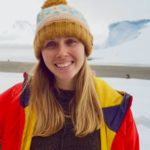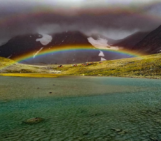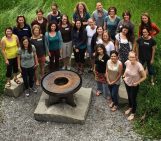 Women make up 50.8% of the worlds population, yet fewer than 30% of the world’s researchers are women. Of this percentage, BAME (Black Asia and Minority Ethnic) comprise around 5%, with less than 1% represented in geoscience faculty positions.
Women make up 50.8% of the worlds population, yet fewer than 30% of the world’s researchers are women. Of this percentage, BAME (Black Asia and Minority Ethnic) comprise around 5%, with less than 1% represented in geoscience faculty positions.
The divide between women in the population and women in STEM needs to be addressed. Through a series of blog posts we hope to raise the voice of women in the cryosphere community, and spread awareness of the amazing work they do.
This Women in cryo blog post will introduce you to Dr Lu Li of NORCE Norwegian Research Centre & Bjerknes Center for Climate research. Lu’s research mostly focuses on hydrological modelling and has regularly been used to approach problems in the cryosphere, such as evaluating the hydrological water budget in the Himalayas, or hydrologically modelling glaciers and ice caps, to mention just a few.
On a cold spring day at a snowy train station in the middle of Norway, I had the pleasure of meeting Dr Lu Li. As we both waited for our taxi (a snow mobile!) to pick us up, we got talking, and I was blown away by Lu’s friendly nature and enthusiasm for science. As a Chinese national living in Norway, Lu’s story into the cryosphere is unique and underrepresented in our community and I couldn’t wait to share her story to the cryosphere community and what life in Norway is like!

Lu’s EvoGlac project field work trip in 2017. At the Finse train station, where Emma and Lu first met, all were waiting for the snow mobile. The taxi driver Kjell Magne is the second one from the right side with ski goggles and helmet. [Photo credit: Lu Li]
Path to the cryosphere
Growing up in a small county nearby a tributary river of Chang Jiang (Yangtze river), Lu was subconsciously exposed to hydrology from a very young age, in fact, its why she thinks she ended up studying it in the first place!
“One of the deepest memories of my childhood was checking the water level of the river during daily walk along the riverbank with my parents after dinner (yep, a family hobby!). There was a stair going down from the top of the riverbank to the river. We were fishing and looking for crab under the stones. It was so amazing to see how large the river’s water level changed seasonally, and we usually guess how high it would go up in summer. There was a big flooding when I was about 7-8 years old. The river stream flowed overbank and filled in everywhere. I lived on the 4th floor so I went down to my friend’s place which was on the first floor. The water level was up to my thigh! I and my friend were fishing at his home (yep, it was fun!). The water went down after a few days and everything became normal again. After that, the riverbank had been reconstructed and became higher and higher every year. Then there was no such flooding thing happened again even in the 1998 China floods.”
From the influence of the river, Lu proceeded to gain a Masters of Engineering in Hydrology and Water resources at Wuhan University, and continued on this path with a PhD. It was here that her first taste of the cryosphere was experienced on a two-months research exchange to the University of Oslo, opening the door for Lu to many international collaborations for hydo-cryosphere research, From India (NORINDIA) to Greenland (ICE2ICE) and back to Norway (EVOGLAC).
“I didn’t envisage the cryosphere would be the end goal. Now, I would admit cryosphere is part of my life.”

Lu’s first cryosphere field work in 2009, measuring snow density and depth in a mountain over Western Norway. [Photo credit: Jianting Chu]
What has been your favourite part/highlight of working in the cryosphere?
“For the field work: Fresh in the field outside and warm&cosy afterwards. For the research work: I think it is the uncertainties and challenges in cold & high-mountainous region, which is much more vulnerable than other regions in the world under warming climate. It makes my work more urgently needed and meaningful for society.”

Lu and her two colleagues from BCCR at the Hardangerjøkulen glacier with eleven high school students from Sandsli in Bergen. [Photo credit: Ellen Viste, read more from Ellen’s BCCR article]
Life in Norway
As English is widely spoken in Norway, the Norwegian Research Centre where Lu works, write, read and speak English every day, which makes the transition for an international researcher easier, but the limitations come when trying to socialise beyond the office.
“My limited Norwegian level constrained a bit of my life quality and social circle. I now feel more language pressure from my 4-year old daughter and her Norwegian friends. I can only recommend to start learning the Norwegian as soon as you get there!”
Moving across the world doesn’t only come with changes in the language but changes in the weather! Norway and Skiing are almost interchangeable, and it was only a matter of time before Lu’s hobbies changed to fit with the environment.
“I used to be a sporty girl. I liked playing basketball and badminton when I was in university. The research career (or maybe the environment) did change me a bit in my hobbies. I have started skiing (both cross country and downhill) since 2009 when I moved to Norway.”
Beyond the slopes, Lu can be found hiking, baking, painting, or recently learning to play the violin to make the most of the COVID restrictions!
What is your recommendation for someone visiting Bergen?
“Get seafood from local supermarket instead of fish market (close to Bryggen) in Bergen! And you have to try the shrimp (Norwegian: reker)! I like the frozen shrimp (Norwegian: Frosne reker) more than the fresh ones (which are a bit too salty for me). Just put it in the tap water for a little while and then enjoy!“
On Being a BAME woman in Science
Being a woman in science can often come with difficulties, when speaking with Lu about her experience, Norway has exceeded in its ability to welcome those from other cultures into their own,
“I don’t feel there is any difference finding a path to the cryosphere as a woman or a man in Norway. There of course has been difficulties, for example, being away from your family especially young child, but it is the same for woman and man. I brought my little girl to EGU in 2016 when she was three months, but I couldn’t do that during a field work!”
It of course also helps that Lu has never been one to think she can’t do something! A mentality we should all adopt,
“When I was a little girl, I believed that there was nothing I couldn’t learn if I really wanted to. This self-confidence has been fading while growing ‘older’.
However, I believe that I should never lose the spirit from that little girl. I think this is not only for those who might want to work in the cryosphere, but also for myself, trying to look inner while keeping it going.”
Dr Lu Li can only be described as an example of international research. With projects spanning across many continents, and assimilating into Norwegian life effortlessly, her story is one to inspire other BAME women looking to endeavour into the research career.
Q&A with Lu
Any cold themed film recommendations?
ICE AGE!
If you didn’t follow the path of the cryosphere, where would you see yourself now?
Probably a teacher in China (In China, only the teachers have one-month winter holiday and two-months summer holiday which are all paid leave!) I knew it when I was little, since my parents are teachers!;-)
If you are feeling unmotivated, what is something you do to help?
Exercise until sweating or go hiking (I live close to mountain). Besides, reading helps, e.g., books of mind & body, a recommendation would be, “The Surrender Experiment: My Journey into Life’s Perfection” by Michael Alan Singer.
If you would like to learn more about Lu’s research…
 …you can check out her three most recent papers, here:
…you can check out her three most recent papers, here:
- Detailed Mass Balance and Hydrological Modeling of the Hardangerjøkulen Ice Cap in South-Central Norway
- The impact of initial conditions on convection-permitting simulations of a flood event over complex mountainous terrain
- Twenty-first-century glacio-hydrological changes in the Himalayan headwater Beas River basin
Or you can email her at luli@norceresearch.no
Edited by Jenny Arthur
 Emma Pearce is a PhD student at the University of Leeds, UK. She investigates the application of using the seismic geophysical technique Full Waveform Inversion (FWI) to model firn. When she isn’t in the office or on fieldwork, Emma can be found climbing, crafting, or being a mum to her pet hamster.
Emma Pearce is a PhD student at the University of Leeds, UK. She investigates the application of using the seismic geophysical technique Full Waveform Inversion (FWI) to model firn. When she isn’t in the office or on fieldwork, Emma can be found climbing, crafting, or being a mum to her pet hamster.
She tweets at @emm_pearce and can be contacted by email on eeevep@leeds.ac.uk






